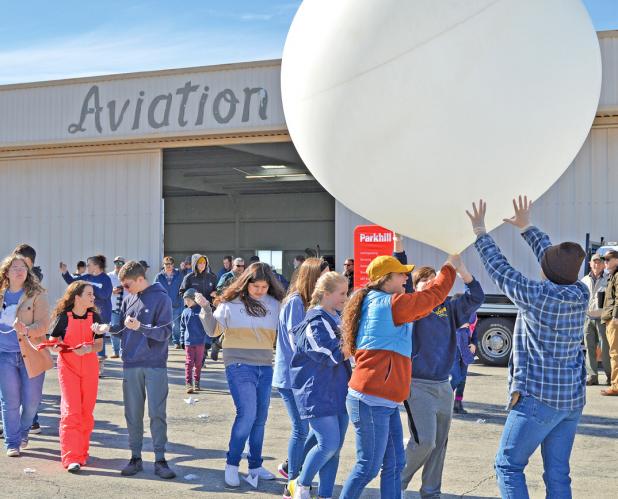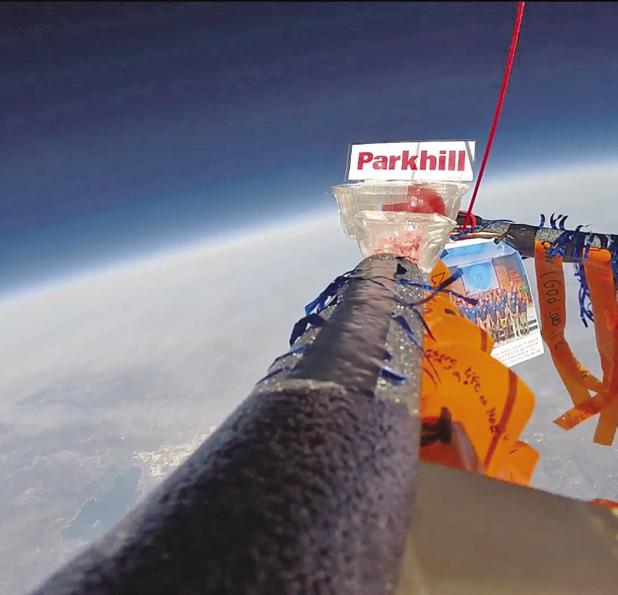

Open Door Christian School students launches high-altitude balloon
Open Door Christian School students successfully launched and recovered a high-altitude balloon containing experiments and GoPro cameras Saturday as part of a Science, Technology, Engineering, and Mathematics project.
The students were tasked with designing a payload that would be lifted into the earth’s atmosphere by a high-altitude balloon. Twenty- two ODCS students in sixth, seventh and eighth grade launched the balloon from Graham Municipal Airport on Saturday, Nov. 12. ODCS STEM Director Claire Meschkat said the second launch from the school was a success reaching a max altitude of 65,000 feet.
“It went a lot smoother this year. We had more students working on it, which was great. They all knew what they’re supposed to be doing. Everything seemed to be going well. (...) We had to remove some things from the payload to make it lighter since we were running out of helium. We wanted to make sure that it would take off, so that went well. We had a tracker that was not responding at first, we were able to overcome that as well. Last time we did this project, we had one tracker that worked (and) this time we had three. So we were determined to find it on the first go around,” she said. “We launched the balloon and then we started immediately getting feedback from the trackers as to where it was and our recovery team took off. Our recovery team was the STEM teacher Laci Nelle, and one of the parents of Raylie Seyler (...) and then it was Raylie and Nolan Wankowicz and (Jack Menard and Lexi Enns).”
During the first project launched by ODCS the balloon landed in a tree in Bedford. This year, the project landed in the back of a pickup truck parked in Keller. Meschkat said the recovery team was able to track the payload and recover it from its end location.
“They were able to pinpoint exactly where it went and it ended up landing in the back of a guy’s pickup truck that was parked in his driveway,” she said. “So apparently what happened is he, the man who lived at the house, came outside and heard a really annoying beeping noise because we had a beacon. Because last time we had it land in a tree and it was dark and so we had our kids (and) we were looking everywhere for it, could not find it. We thought this time, if we can’t see it we need to be able to hear it and so we added a beacon that was making this really annoying beeping noise. So this man heard this noise coming from his truck and I’m sure he was like, ‘Oh, no, what’s happening.’ So he found our payload in the back of his pickup and was able to call Laci because our picture of our students and her phone number were on the payload. The first thing that she said is how to disconnect the battery to the beacon so it stopped that annoying noise. But it was a super easy recovery, we knew exactly where it was. It was in Keller, Texas, so we traveled about 85 miles.”
Two GoPro cameras were attached to the balloon to capture footage of its journey. One was aimed at the two science experiments on the base of the project and another was pointed directly down. The payload also had instruments attached which were supposed to measure temperature, pressure and humidity, but Meschkat said the devices did not function as expected.
“So we don’t have the scientific data that we were hoping for, but that was okay, because we have the trackers that took altitude measurements. We can go back and look at what the temperature readings were at the different altitudes and the different locations,” she said. “The students were able to take the science experiments that were on board and then do further testing in the classroom once we got it back. So they’d compare the Pop Rocks that were on board to Pop Rocks that were new, and the bouncy ball to see if there was any difference in how an identical bouncy ball bounces if it lost elasticity by going up to the sub-zero temperatures or not, so we’re still processing that data.”
